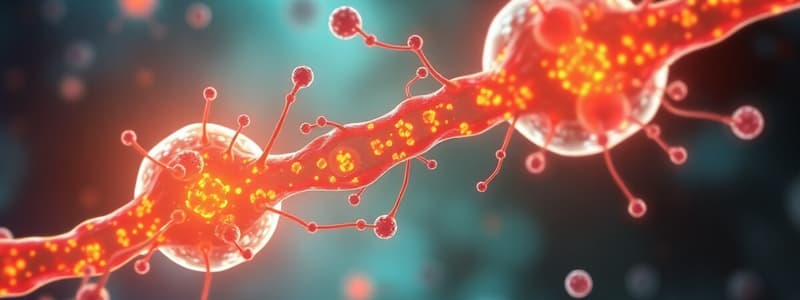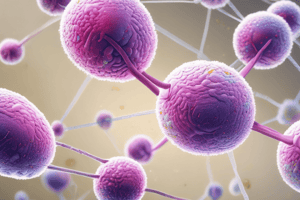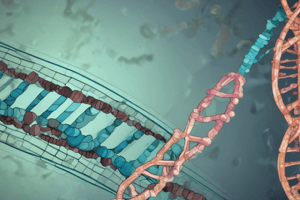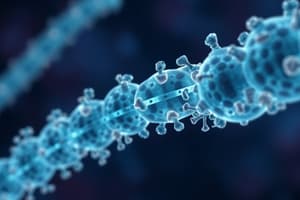Podcast
Questions and Answers
What is the primary sequence of the telomeric DNA found in human cells?
What is the primary sequence of the telomeric DNA found in human cells?
- ATCGTA
- GGTACC
- CCTAGG
- TTAGGG (correct)
Which component of telomerase provides the template for DNA synthesis?
Which component of telomerase provides the template for DNA synthesis?
- Reverse transcriptase
- Accessory protein subunits
- RNA subunit (correct)
- Telomerase complex
Which cell types predominantly express telomerase in humans?
Which cell types predominantly express telomerase in humans?
- Cardiac muscle cells
- Germ line cells and stem cells (correct)
- All fully differentiated somatic cells
- Only skin cells
What is one major function of telomeres in eukaryotic cells?
What is one major function of telomeres in eukaryotic cells?
Where is the assembly of the telomerase holoenzyme believed to be completed?
Where is the assembly of the telomerase holoenzyme believed to be completed?
What is a key feature of telomerase-directed DNA synthesis?
What is a key feature of telomerase-directed DNA synthesis?
Which of the following best describes how telomerase is disrupted?
Which of the following best describes how telomerase is disrupted?
What is the structural composition of telomerase?
What is the structural composition of telomerase?
What is the purpose of the first filter in a fluorescent microscope?
What is the purpose of the first filter in a fluorescent microscope?
Which step follows the incubation of a sample with a primary antibody in immunofluorescence staining?
Which step follows the incubation of a sample with a primary antibody in immunofluorescence staining?
What is a key feature of immunofluorescence staining methods?
What is a key feature of immunofluorescence staining methods?
Why are cells treated with a detergent during immunofluorescence staining?
Why are cells treated with a detergent during immunofluorescence staining?
In fluorescence in situ hybridization (FISH), what is the role of the oligonucleotide probe?
In fluorescence in situ hybridization (FISH), what is the role of the oligonucleotide probe?
What is the importance of using a powerful light source in fluorescence microscopy?
What is the importance of using a powerful light source in fluorescence microscopy?
Which statement is true regarding the filters used in fluorescent microscopy?
Which statement is true regarding the filters used in fluorescent microscopy?
What result does merging different dye-conjugated antibodies in a sample allow?
What result does merging different dye-conjugated antibodies in a sample allow?
What role does telomerase play in the S phase of the cell cycle?
What role does telomerase play in the S phase of the cell cycle?
What happens to telomeres in normal human somatic cells during each cell division?
What happens to telomeres in normal human somatic cells during each cell division?
Which statement best describes the outcome when telomerase is inhibited in stem or cancer cells?
Which statement best describes the outcome when telomerase is inhibited in stem or cancer cells?
What is a main characteristic of replicative senescence?
What is a main characteristic of replicative senescence?
How does telomerase activity in mouse somatic cells differ from that in human cells?
How does telomerase activity in mouse somatic cells differ from that in human cells?
What is the primary use of fluorescence microscopy?
What is the primary use of fluorescence microscopy?
What is a consequence of the end-replication problem in somatic cells?
What is a consequence of the end-replication problem in somatic cells?
During which phases of the cell cycle does telomerase remain sequestered in CBs in human somatic cells?
During which phases of the cell cycle does telomerase remain sequestered in CBs in human somatic cells?
Flashcards
Telomere Structure
Telomere Structure
Telomeres are repetitive DNA sequences at the ends of linear chromosomes in eukaryotic cells.
Human Telomere Sequence
Human Telomere Sequence
Human telomeres contain repeating TTAGGG sequences, followed by a G-rich 3' overhang.
Telomerase Function
Telomerase Function
Telomerase extends telomeres by adding telomeric repeats.
Telomerase components
Telomerase components
Signup and view all the flashcards
Telomere Protection
Telomere Protection
Signup and view all the flashcards
Telomere Replication
Telomere Replication
Signup and view all the flashcards
Telomerase Expression in Cells
Telomerase Expression in Cells
Signup and view all the flashcards
Shelterin Complex
Shelterin Complex
Signup and view all the flashcards
Telomeres shortening
Telomeres shortening
Signup and view all the flashcards
Replicative senescence
Replicative senescence
Signup and view all the flashcards
Cellular Senescence Protection
Cellular Senescence Protection
Signup and view all the flashcards
Telomerase and Cancer
Telomerase and Cancer
Signup and view all the flashcards
CBs (Co-Centric Bodies)
CBs (Co-Centric Bodies)
Signup and view all the flashcards
End-Replication Problem
End-Replication Problem
Signup and view all the flashcards
Telomere Length Homeostasis
Telomere Length Homeostasis
Signup and view all the flashcards
Fluorescence
Fluorescence
Signup and view all the flashcards
Fluorescent Microscopy
Fluorescent Microscopy
Signup and view all the flashcards
Immunofluorescence Staining
Immunofluorescence Staining
Signup and view all the flashcards
Primary Antibody
Primary Antibody
Signup and view all the flashcards
Secondary Antibody
Secondary Antibody
Signup and view all the flashcards
Fluorescence In Situ Hybridization (FISH)
Fluorescence In Situ Hybridization (FISH)
Signup and view all the flashcards
Fixation
Fixation
Signup and view all the flashcards
Permeabilization
Permeabilization
Signup and view all the flashcards
Study Notes
Telomere Maintenance in Human Cells
- Telomeres are located at the ends of linear chromosomes in eukaryotic cells
- They consist of repetitive sequences (TTAGGG) and a G-rich 3' overhang
- Telomeres protect chromosome ends from being misprocessed as double-stranded DNA breaks
- Telomeres shorten with each cell division, partly because of the end replication problem
- Telomerase is a ribonucleoprotein complex that extends telomeres
- Telomerase contains a reverse transcriptase that adds TTAGGG repeats to the 3' end of telomeres
- Telomerase uses its RNA subunit as a template for synthesis
- Telomerase is typically active in germline cells, stem cells, and cancer cells
- Human somatic cells lack detectable telomerase activity
- Loss of telomerase activity leads to cellular senescence, where cells stop dividing
- Loss of telomeres can activate DNA damage pathways and trigger cellular senescence
Telomere Maintenance in Human Cells: Differences Between Humans and Mice
- Telomerase is active in mouse somatic cells.
- Telomerase activation isn't critical for mouse tumorigenesis.
- Mouse models aren't always ideal for studying telomerase activity regulation in cancer.
Microscopy Techniques
- Light microscopy: uses lenses to magnify images of specimens. Magnification up to 1000x.
- Fluorescence microscopy: uses fluorescent molecules that emit light at a different wavelength than the excitation light.
- Immunofluorescence staining: allows for the localization of specific proteins in cells/tissue. This method uses a primary antibody that binds to the target protein and secondary antibody conjugated with a fluorescent dye to detect the protein of interest.
- Fluorescence in situ hybridization (FISH): visualizes nucleic acids (genes/mRNA) in cells or tissue. It involves using fluorescently tagged DNA or RNA probes that hybridize to their complementary DNA sequences
Studying That Suits You
Use AI to generate personalized quizzes and flashcards to suit your learning preferences.




